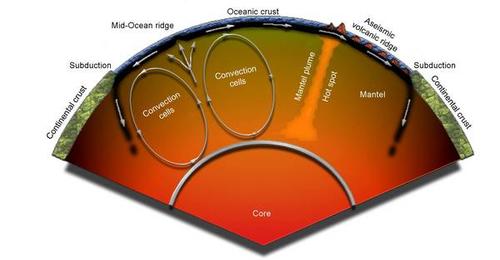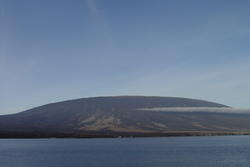Hot-spot Volcanism
It is apparent already at first view that the active volcanoes of Galapagos and Hawaii are not located near plate boundaries of the Earth's lithosphere along which the great majority of the world's earthquakes and volcanic activity occurs. Located more than 1000 km from the closest subduction zone and a few hundred km from the nearest Mid-Oceanic Ridge in the Pacific Ocean, the presence of these volcanic islands represent a very different geodynamic setting and origin.
Therefore, some four decades ago, the “Hot-Spot” hypothesis became widely accepted because it agrees well with scientific data obtained around the globe. A "hot spot" represents a region of volcanism above a relatively stationary region of intense heat within the Earth's mantle, a so-called mantle plume. Lithospheric plates override this “long-living” hot spot and are occasionally perforated by its rising magma. The lithosphere above the mantle plume is thus thickened and heated and therefore becomes more buoyant. Eventually, submarine or subaerial volcanoes form on top. In case of the oceanic plate shown above, volcanic islands form above the mantle plume after submarine volcanism. With continued activity, the previously formed volcanic islands on the plate move away from the hot spot, making room for new islands to be formed by subsequent volcanic activity. Volcanoes become inactive, their edifices are eroded, and they gradually sink below sea level. Because the underlying volcanic material gradually cools and the volcanic complex becomes denser and heavier, hot spot-related volcanic chains often have a bathymetric expression of linear volcanic chains thousands of kilometers long.
The Hot-spot concept is one of several geologic explanations for the origin of the Galapagos Islands, which postulates a small area of abnormally hot rock, a “hot spot”, deep beneath the ocean floor. The hot spot is firmly rooted in the Earth´s interior, while the bedrock of the ocean floor glides slowly over it. Molten rock erupts from the hot spot onto the ocean floor and builds a volcano, which grows above the waves until the ocean floor carries it far to the east. Beyond its lava supply, the old volcano "goes out of business", and a new volcano begins to build above the hot spot.
It might sound curious to imagine that solid rock flows in convection currents inside the Earth due to the fact that the rocks we know at the Earth´s surface are cold, stiff and brittle but it does so in the Earth’s interior where very high pressures and temperatures rule. Under such circumstances rocks become soft and plastic in much the same way that hard wax becomes soft and pliable as it warms in one's hand.
The geneal assumption is that hot rock in the upper mantle sometimes rises in narrow plumes, like smoke rising from a chimney. A plume head heats the lower side of the Earth´s outermost solid layer, the lithosphere, and, when the mantle plume burns its way through it, leads to eruptions of a basaltic flows which may form large igneous provinces that include huge oceanic plateaus.
The underlying plumes are nearly undetectable to most of the conventional methods used to examine the Earth´s interior. Geoscientists of all kinds have little firm data to help explain how plumes start rising or from what depth. The vapors blowing out of hot spot volcanoes contain surprisingly high concentrations of some rare elements, which are not frequently found at the Earth´s surface. Some geologists regard this as evidence that the plume is rising from an extremely deep root; others do not. Some geologists believe that hot spot plumes start spontaneously where large masses of hot rock rise from peaks in the outer boundary of the Earth´s molten core. Others suggest that they originate at depths of only 650 to 670 km, where we encounter the boundary of Earth´s upper and lower mantle, where pressures forces the abundant mineral olivine to change its crystalline structure, forming a boundary from which escaping heat can rise.
Another group of geologists believe that a hot spot rises due to subducted oceanic crust which did not melt completely at subduction zones. This unmolten part either sinks to the Earth´s upper / lower mantle boundary or even to the lower mantle / outer core boundary at 2900 km depth. After a certain residence time, it may become “recycled” thus becomes lighter and therefore less dense which leads this material to rise and form a hot spot.
Some geologists even speculate that plumes develop at sites where enormous asteroids have struck the Earth in the past and exploded, opening a path for heat to escape from the interior. However, reliable data are still lacking for all theories.
Nonetheless, a growing fraction of scientists, based on their data, conclude that mantle plumes simply don't exist. Their theory explains the presence of a volcanic Galapagos or Hawaii by simple cracks or fissures in tectonic plates. After all, plates stretching thousands of kilometers are unlikely to remain perfectly unbroken. Any break in the skin of a plate would reasonably enough be flooded with molten rock to fill this potential gap.


